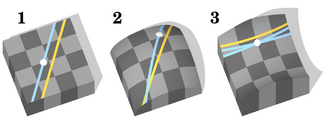Ambient space
An ambient space or ambient configuration space is the space surrounding an object.
While the ambient space and hodological space are both considered ways of perceiving penetrable space, the former perceives space as navigable, while the latter perceives it as navigated.[1]
Mathematics
In mathematics, especially in geometry and topology, an ambient space is the space surrounding a mathematical object along with the object itself. For example, a 1-dimensional line [math]\displaystyle{ (l) }[/math] may be studied in isolation —in which case the ambient space of [math]\displaystyle{ l }[/math] is [math]\displaystyle{ l }[/math], or it may be studied as an object embedded in 2-dimensional Euclidean space [math]\displaystyle{ (\mathbb{R}^2) }[/math]—in which case the ambient space of [math]\displaystyle{ l }[/math] is [math]\displaystyle{ \mathbb{R}^2 }[/math], or as an object embedded in 2-dimensional hyperbolic space [math]\displaystyle{ (\mathbb{H}^2) }[/math]—in which case the ambient space of [math]\displaystyle{ l }[/math] is [math]\displaystyle{ \mathbb{H}^2 }[/math]. To see why this makes a difference, consider the statement "Parallel lines never intersect." This is true if the ambient space is [math]\displaystyle{ \mathbb{R}^2 }[/math], but false if the ambient space is [math]\displaystyle{ \mathbb{H}^2 }[/math], because the geometric properties of [math]\displaystyle{ \mathbb{R}^2 }[/math] are different from the geometric properties of [math]\displaystyle{ \mathbb{H}^2 }[/math]. All spaces are subsets of their ambient space.
See also
- Configuration space
- Manifold and ambient manifold
- Submanifolds and Hypersurfaces
- Riemannian manifolds
- Ricci curvature
- Differential form
References
- ↑ McMurtrie, Robert James (2017). The Semiotics of Movement in Space. New York: Routledge. pp. 41. ISBN 9781138191716.
Further reading
- Schilders, W. H. A.; ter Maten, E. J. W.; Ciarlet, Philippe G. (2005). Numerical Methods in Electromagnetics. Special Volume. Elsevier. pp. 120ff. ISBN 0-444-51375-2.
- Wiggins, Stephen (1992). Chaotic Transport in Dynamical Systems. Berlin: Springer. pp. 209ff. ISBN 3-540-97522-5. https://archive.org/details/chaotictransport0002wigg.


